

CLIL Projects and Materials (ready to be used) / Actividades y materiales CLIL - listos para usar / Home. SET2CLIL Project web site. History of CLIL. Front Page - CLIL Media. CLIL: What is CLIL? Defining CLIL. There was a lot of discussion about what exactly CLIL is, whether it is different from other approaches such as EMI (English as a Medium of Instruction) or CBI (Content-based Instruction) or CALLA (Cognitive Academic Language Learning Approach).

One colleague sees CLIL as a special form of TEFL, with the main emphasis being on the language. Another colleagues is equally sure that 'CLIL is of course content-based instruction, which is an area loaded with confusing and overlapping terminology (CLIL, SIOP, ESP, EAP, Sheltered, task-based, immersion, etc.)'. A useful distinction is drawn between 'cross-curricular' language teaching - teaching normal academic subjects in English to non native speakers - and other types of content based teaching where the content is given priority to the linguistic aims.
One colleague asks if the time has come to begin labelling parts of the CLIL continuum in order to define more precisely what goes on in the classroom. Article: What is CLIL? By Phil Ball Despite the self-explanatory nature of the phrase 'Content and Language Integrated Learning', the true nature of CLIL still remains elusive.
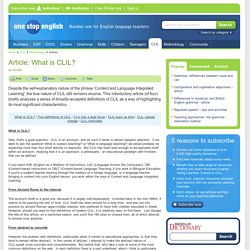
This introductory article (of four) briefly analyses a series of broadly-accepted definitions of CLIL as a way of highlighting its most significant characteristics. CLIL Glossary. Tigtag CLIL. CLIL IN ACTION – TEAM TEACHING. Article: Skills for CLIL. In this article John Clegg outlines the language and learning skills which a learner learning a subject through the medium of English as a second language (L2) requires. 1.

Introduction What I want to do in this article is outline the language and learning skills which a learner learning a subject through the medium of English as a second language (L2) will need. This learner is typically learning the whole of the subject in English for some years or throughout schooling. 2. Cambridge TKT CLIL Glossary. KS what? They key stages clarified once and for all. When looking for interesting new authentic material to use in my lesson, I often encounter the fact that the different education orientated materials found on the web are categorised in different key stages.
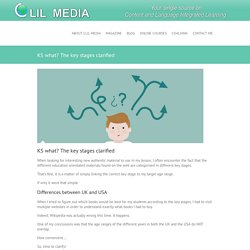
That’s fine, it is a matter of simply linking the correct key stage to my target age range. If only it were that simple. Differences between UK and USA When I tried to figure out which books would be best for my students according to the key stages, I had to visit multiple websites in order to understand exactly what books I had to buy. Indeed, Wikipedia was actually wrong this time. One of my conclusions was that the age ranges of the different years in both the UK and the USA do NOT overlap. How convenient… Tests created by students: CLIL at its finest. For some time now, I have asked students to create activities for each other.
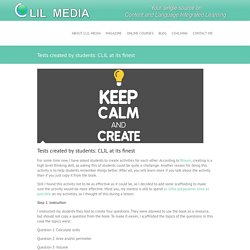
According to Bloom, creating is a high level thinking skill, so asking this of students could be quite a challenge. Another reason for doing this activity is to help students remember things better. After all, you will learn more if you talk about the activity than if you just copy it from the book. Still I found this activity not to be as effective as it could be, so I decided to add some scaffolding to make sure the activity would be more effective. Five of the best CLIL resources online - CLIL Media. In the posts on this website I usually share my opinion on CLIL as well as share some ideas of others.
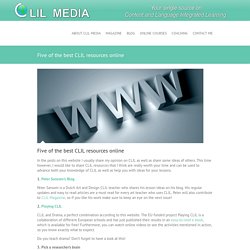
This time however, I would like to share CLIL resources that I think are really worth your time and can be used to advance both your knowledge of CLIL as well as help you with ideas for your lessons. 1. Peter Sansom’s Blog Peter Sansom is a Dutch Art and Design CLIL teacher who shares his lesson ideas on his blog. How to design a great CLIL activity. A lot has been written about CLIL activities.

The very good book “CLIL Activities” by Liz Dale and Rosie Tanner, but also “CLIL Skills” and “The TKT Course CLIL Module” are very interesting reads if you want to find inspiration for your own CLIL activity. However, I still hear teachers say they think CLIL is a lot of work. They say they don’t want to ‘change their entire lesson’. They ‘don’t have time‘. What is CLIL -Wielander CLIL at aston university. Checklist how ClIL are you & Scoring. How ready are you and your school for CLIL. A CLIL Guide 5 activities for every CLIL teacher. WHAT IS CLIL? - CLIL principles. CLIL stands for Content and Language Integrated Learning.
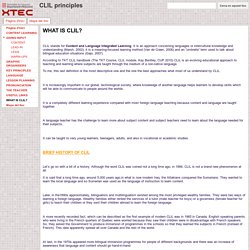
It is an approach concerning languages or intercultural knowledge and understanding (Marsh, 2002); it is a meaning-focused learning method (Van de Craen, 2006) and an “umbrella” term used to talk about bilingual education situations (Gajo, 2007). According to TKT CLIL handbook (The TKT Course, CLIL module, Kay Bentley, CUP 2010) CLIL is an evolving educational approach to teaching and learning where subjects are taught through the medium of a non-native language.
To me, this last definition is the most descriptive one and the one the best approaches what most of us understand by CLIL. It is increasingly important in our global, technological society, where knowledge of another language helps learners to develop skills which will be able to communicate to people around the worlds. It is a completely different learning experience compared with most foreign language teaching because content and language are taught together. Language Value. Language Value publishes articles, review and commentary essays aiming to the interdisciplinary analysis of English language use.
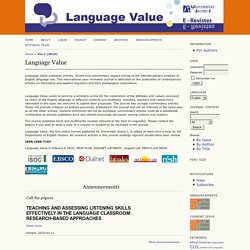
This international peer-reviewed journal is dedicated to the publication of contemporary articles on theoretical and applied linguistics and their pedagogical implications. Language Value seeks to become a scholarly arena for the exploration of the attitudes and values conveyed by users of the English language in different contexts and situations. The CLIL Guidebook.
Clil4U CLIL implementation with pools of resources for teachers, students, and pupils. Back to Top The project needs were based on several reports, e.g.

Eurydice “Content and Language Integrated Learning (CLIL) at School in Europe 2006” which in “Factors inhibiting general implementation” points at a need for training language teachers in the special skills needed to provide CLIL through initial and in-service training programs devoted to methods used to teach a subject in other languages. The report also points at a need for teaching materials geared to CLIL in the target language that cover subjects in the national curriculum.
CLIL: A lesson framework. Underlying principles Classroom principles Lesson framework Conclusion Underlying principles The principles behind Content and Language Integrated Learning include global statements such as 'all teachers are teachers of language' (The Bullock Report - A Language for Life, 1975) to the wide-ranging advantages of cross-curricular bilingual teaching in statements from the Content and Language Integrated Project (CLIP).
The benefits of CLIL may be seen in terms of cultural awareness, internationalisation, language competence, preparation for both study and working life, and increased motivation. Teachers' Competence Grid. CLIL – how to do it. “Chris, we’ve been asked to work with some schools to develop their CLIL courses. Can you look after that?” That was the first time I heard the term CLIL. I said yes, not really knowing what I was letting myself in for, but now, many years down the line I hope some things I learnt can be of use to others having to design and teach CLIL courses. Much has been written on what CLIL is and why to do it, for example the articles on TeachingEnglish, but there is very little practical guidance on how to plan and teach CLIL lessons. If you are a subject teacher who has been asked to teach in English (or any other language for that matter), or a language teacher who has been asked to help teach content then this article will show you where to start.
Where to startThe first things to think about when planning a CLIL lesson, or indeed a whole course, are the who and the what. A colleague in a Japanese university recently explained to me how he chose his materials. By Chris Baldwin. Five of the best CLIL resources online - CLIL Media. Latin American Journal of Content & Language Integrated Learning. LACLIL is a no-fee, open-access, peer-reviewed journal focused on CLIL (Content and Language Integrated Learning), multilingualism, interculturalism, and CALL, throughout Latin America and around the world. Indexed in: DOAJ, Linguistics Abstracts Online, Google Scholars, MLA Bibliography - Language, Linguistics and Literature, Open J-Gate, Directory of Research Journals Indexing, EBSCO, ProQuest, e-revist@s, Publindex Category C.
Università degli Studi di Foggia. European Framework for CLIL teacher education.
Video for all. Clilstore - Teaching units for content and language integrated learning. Teaching unitsfor Content and Language Integrated Learning HelpAbout Select the language you are learning and your level to see the available units. Level AnyBasicA1A2B1B2C1C2Advanced This project has been funded with support from the European Commission. Disclaimer: This publication reflects the views only of the author, and the Commission cannot be held responsible for any use which may be made of the information contained therein. PhET – Interactive Physics Simulations - A trip to CLIL. Onestopenglish. Coyle CLIL planning tool -kit.
CLIL Art: Dali. CLIL for the e-Generation-Frigols. Curso CLIL. Using CLIL. CLIL – a difficult challenge? The 4 C’s model – Do Coyle. The lighter version CLIL is complex and context-sensitive.There are general parameters for CLIL.These are: Cognition, Culture, Content, Communication.Any particular CLIL model or methodology needs to consider the relative value/importance of the parameters above.Language as a learning tool operates in three ways: OF – FOR – THROUGH The 4Cs Framework Coyle, D. (2008).
Outcomes and processes in Content and Language Inte grated Learning (CLIL): current research from Europe. Grahamworkmanbili - CLIL Test. Un Rincón en la Clase: El método CLIL. El término AICLE (Aprendizaje Integrado de Contenidos y Lenguas Extranjeras), o CLIL en inglés (Content and Language Integrated Learning) fue acuñado en 1994 en Europa. Se trata de un doble enfoque en el que se usa una lengua adicional para aprender y enseñar tanto contenido como lengua: por ejemplo, aprender matemáticas utilizando el español en aulas estadounidenses. Usar AICLE en la escuela significa usar una lengua distinta a la materna como medio de instrucción y aprendizaje de asignaturas como matemáticas, ciencias o historia.
Sin embargo, también es necesario enseñar la propia lengua, por lo que nos encontramos con dos tipos de profesores:El profesor de contenido, quien emplea la lengua meta para enseñar matemática. El profesor de lengua, quien se dedica a dar clase de esa lengua meta, digamos español. El profesor de lengua enseña español. Pero, en realidad, lengua y contenido están unidas. AICLE es un método basado en integración: El curso y su contenido Concluimos. CLIL - Teacher's Zone. The aim of this activity is to teach students that breakfast is the most important meal during a day. Your CLIL. In this monthly series, Keith Kelly provides a comprehensive lesson plan focusing on both content and language, accompanied by a useful word list highlighting language used in core function areas of different subjects. These lesson plans and word lists are the result of analysis into the language of the content subjects: geography, biology, chemistry and physics.
CLIL Resources for Higher Education. Materials for higher education Published articles Sociology of Education (en) by López (2011), 1st year, Pre-school and Primary Education.History of Spain (es) by Romero y Crean (2009), REVISTA ICONO 14, 2009, Nº 14, pp. 176-190, 1st year, Journalism. We have just started posting materials for UVic courses. Here you will find examples of lesson plans, units of work or course descriptions developed by UVic teachers.